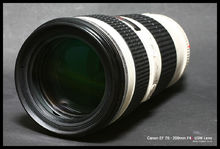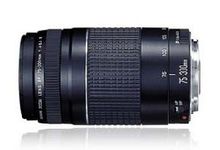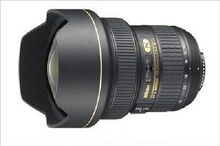Zoom lens
This article refers to the address: http://
The zoom lens is a camera lens that can change the focal length within a certain range to obtain different wide and narrow angles of view, different sizes of images and different scene ranges. The zoom lens can change the shooting range by changing the focal length without changing the shooting distance, which is very advantageous for picture composition. Since a zoom lens can serve as a plurality of fixed-focus lenses, the travel time not only reduces the number of carrying photographic equipment, but also saves time for lens replacement.
Introduction to zoom lens
The disadvantages of the zoom lens compared to the fixed focus lens:
1. expensive;
2. Large volume;
3. At any given focal length, the imaging is often not as clear as the best fixed-focus lens.
Regardless of these inherent flaws, the optical industry has used computers to design lenses, and has already produced many excellent zoom lenses. The imaging of many zoom lenses is very clear, and the size is quite small, but the price is still very expensive.
Zoom lens use
When using a zoom lens for focusing, it is best to first focus the image to the maximum for focusing; that is, focus using the longest focal length of the lens. Then, reduce the focal length to the desired focal length at the time of shooting. During this process, the images on all focal lengths are always clear. With this technique, it is easier to observe whether the image details are clear and therefore the most accurate method of focusing because it is focused under the largest possible image. Note that some zoom lenses require two separate control loops, one to control focus and the other to control focus. The advantage of this structural layout is that once the focus is completed, the focus is not accidentally changed by adjusting the focal length.
Other zoom lenses only need to move a control ring, turn it to focus, and slide it back and forth to change the focus. This "single-ring" zoom lens is often faster and more convenient for operation, but it is usually more expensive. Be aware that when changing the focus, don't lose sharp focus.

The white picture shows one of the more commonly used zoom lenses, Canon EF 70-200mm f/2.8L USM, commonly known as white.
Zoom lens features
The biggest feature of the zoom lens, or its greatest value, is that it realizes the function that the lens focal length can be changed according to the photographer's wishes. versus

The zoom lens has a fixed focal length lens. The zoom lens does not rely on the quick change lens to achieve the focal length conversion of the lens. Instead, the focal length of the lens is changed by pushing or rotating the zoom ring of the lens. In the zoom range of the lens, the focal length can be stepless. The transformation, that is, any focal length within the zoom range, can be used for photography, which creates conditions for diversification of the composition. The focal length of any zoom lens of the zoom lens itself is the same as that of other fixed focal length lenses of the same focal length. However, the zoom lens does not limit which level of focal length the photographer uses, and thus is much more convenient and flexible in use. It eliminates the need to carry and replace multiple different focal length lenses when shooting out. Even before pressing the camera shutter, the photographer can also make a choice by changing the focal length of the lens to crop the image, in order to arrange the picture composition more ideally before shooting. The zoom lens zooms in to the focal length, which is a fixed focal length lens that cannot be compared by changing the focal length of the lens. The zoom lens of the 35mm automatic compact camera or some 35mm single-lens reflex camera also adopts the power zoom mode. The power zoom is not only labor-saving and convenient, but more importantly, it achieves the constant-speed zoom, which is the photographer's focal length. It is very advantageous to finely change the cropped image and determine the composition. The zoom lens can also perform an "explosion effect" by zooming at the moment the camera shutter is opened. Some cameras also rely on automatic control of the focal length conversion of the zoom lens to achieve automatic composition. The most innovative 35mm single-lens reflex camera is also equipped with an automatic memory lens focal length function, which allows the photographer to set the camera to record one or several lens frequencies that are used more frequently, and to focus on the lens at any time. Change to the focal length of the previous memory.
Of course, compared with a fixed focal length lens, the structure of the zoom lens is relatively complicated and the component is heavy. For non-branded zoom lenses, the image quality is definitely inferior to the corresponding fixed focus lens.
Zoom lens classification
According to the external dimensions, the camera lens is divided into a box lens and a portable lens. In theory, the lens of the box lens is larger and the optical characteristics are stronger than the portable lens. The focal length change and focus of the box lens can only be performed by changing and focusing the servo handle, and the change and accumulation of the portable lens can be selected by manual operation or servo operation through the switch on the lens.
According to the zoom range, the camera lens can be divided into a wide-angle lens, a standard lens, and a telephoto lens. The focal length is a basic feature of the lens that determines the magnification of the image and the horizontal field of view captured by the lens. The focal length is determined by measuring the distance from the optical center of the lens to the point at which the light converges behind the lens to produce a sharp image. For a television camera, this point is the target surface of the CCD. The shorter the focal length, the wider the horizontal field of view, and the smaller the image, the narrower the horizontal field of view as the focal length increases, and the subject increases.
Zoom range
The zoom lens is usually illustrated by a binary array such as “21×7.5â€. The front number “21†is the zoom range, which is the ratio of the longest focal length to the shortest focal length of the lens; the latter number “7.5†is The shortest focal length in millimeters, which indicates the maximum viewing angle of the zoom lens. Knowing this meaning makes it easy to know that this zoom lens can be changed from 7.5 mm (the focal length of the maximum viewing angle that can be obtained) to 157.5 mm (the longest focal length available).

The diagram knows the focal length (f) of the lens and the distance (d) of the captured subject. It is easy to calculate the size of the scene (horizontal direction) and y (vertical direction) that the camera can capture. This helps the cameraman to The purpose of the selection is to use lenses with different zoom ranges. The calculation method is described below: the CCD used in the studio camera is 2/3 inch, and its imaging size is 8.8×6.6 mm, x=8.8 (d/f) mmy=6.6 (d/f) mm.
With the improvement of the lens manufacturing level, the current camera wide-angle lens has a minimum focal length of 4 mm (can take a panoramic view of a height of 1.8 meters from a camera 1 meter away), while the telephoto lens has a maximum focal length of more than 1100 mm ( It is amazing to be able to take a panoramic view of a person 1.8 meters high from a camera 300 meters away. I couldn’t imagine it before. In addition, for the portable lens, the inner focus lens and the outer focus lens can be classified according to the movement state of the focus group lens at the time of focusing. When the inner focusing lens is adjusted, the frontmost one of the first three lenses of the focusing group is fixed, and only the middle one or the latter one moves, so the hood fixed on the sleeve does not rotate with the focusing, allowing shading The cover is made into a square mouth, which can effectively reduce stray light and improve image quality. However, the inner focusing lens requires a double-layered sleeve structure, which requires high mechanical precision. Several lenses and hoods of the outer focusing lens focusing group are fixed on one sleeve, several lenses move at the same time, and the hood moves with it, so only the circular hood can be installed, and the effect of reducing stray light is not as good as square shading. Cover, but the mechanical structure is simple.
Zoom principle
Optical zoom is to change the focus position by moving the lens inside the lens, change the length of the lens focal length, and change the angle of view of the lens to achieve image enlargement and reduction. In the above image, the long right angle of the red triangle is the focal length of the camera. When the position of the focus is changed, the focal length also changes. For example, if the focus is moved in the opposite direction to the image plane, the focal length will become longer and the angle of view in the figure will become smaller. In this way, the scene within the viewing angle will become larger on the imaging surface.

Lens adjustment
The daily operation of the zoom lens is the dimming circle and the change and focus, but in order to ensure the normal operation of the zoom lens, the adjustment of the back focus, the use of the magnification mirror and the super close-up lens, the use of the neutral filter and the aperture tracking Adjustment is very important.
Back focus adjustment
The back focus needs to be adjusted when the lens is newly mounted to the camera or the image sharpness changes with the focal length at the zoom. The adjustment method is as follows:
Take a picture with different details (preferably a dedicated test card) with an object distance of 3 to 5 meters and adjust the aperture to the appropriate position to get a clear image on the viewfinder.
Use the focus ring to adjust the image to the best sharpness at the longest focal length. Adjust the back focus ring at the shortest focal length to optimize image clarity. When adjusting the back focus ring, loosen the locking screw before turning the back focus ring.
Repeat the first two steps until the focus is accurately tracked, the image clarity remains the same at zoom, and then tighten the set screws on the back focus ring.
Use of magnification mirror
The focal length of a zoom lens has a limited range of continuous adjustment. For example, a 21×7.5 zoom lens can be changed from 7.5 mm (the focal length of the maximum viewing angle) to 157.5 mm (the longest focal length), and its zoom magnification is 21. If the magnification mirror (EXT) selector switch is changed from ×1 to ×2, the zoom factor is still 21, but the range of focal length change is changed to 2×(7.5~157.5)=15 mm~315 mm. There are several issues to be aware of when using a magnification mirror:
After adding the magnification mirror, the relative aperture of the lens is reduced, and the luminous flux reaching the image plane is reduced to 1/4 of the original. Therefore, the aperture needs to be increased by two steps. It is not advisable to use the magnification mirror when the light is dim, otherwise the captured image will be dark.

When the zoom lens uses a magnification mirror, the perspective distortion and geometric distortion of the captured image will become larger.
Use of super close-up lens
The close-up distance of each lens is more than 60 cm, and it is impossible to focus on objects within the close-up distance. In order to capture objects close to the lens, the zoom lens is equipped with a super close-up lens at the back of the lens, labeled "MACRO". The method of using the super close-up lens is as follows: Lift or release the lock pin on the super close-up lens ring (depending on the specific structure), turn the super close-up ring and push it toward the white line marked with the MACRO word until it is pushed. Do not move.
Rotate the lens's focus ring to the shortest distance.
Align the subject and adjust it with the focus ring to shoot.
After the shooting is completed, the super close-up ring and the lock nail are restored to their original state.
Depth of field control
Whenever the lens is focused on a subject, all objects within a range of the subject before and after the subject are also clear. This sharply defined range is called depth of field, and it serves as an important optical feature of the lens as a tool for artistic creation. When the main subject and all the surrounding objects can focus on a clear space, it is said that the depth of field of the lens is large; if the space around the main subject is not large, the depth of field of the lens is said to be small. Depth of field is important both from an artistic and technical point of view. Artistically speaking, depth of field plays an important role in the overall perspective of the creation of the lens; technically, a lens with a large depth of field is easier to shoot. If the depth of field is small, it is necessary to follow the camera or the subject. The movement is constantly focusing.
The three elements that determine the depth of field of a shot are the focal length, the aperture, and the distance between the camera and the subject.
The shorter the focal length of the lens, the greater the depth of field, and the depth of field decreases as the focal length increases.
The smaller the aperture of the lens, the greater the depth of field.
The greater the distance between the subject and the camera, the greater the depth of field.
Further, the depth of field is greater behind the main subject than the front distance, that is, the sharp focus of those objects behind the main subject is larger than the front range.
Transmittance
F is the transmittance of the lens. The smaller the F, the better the light transmission of the lens. f is the magnification ratio of the lens. For example, when f=1.4, that is, at a fixed position, the picture can be enlarged by 1.4 times. The aperture of the lens is represented by a numerical value. Generally, it is from 1.6 to 2.0. It is convenient to use. A lens has multiple apertures. The larger the aperture, the smaller the aperture and the less the luminous flux. The maximum aperture of each lens is Use the value to mark the front of the lens.
The focal length is also expressed by numerical values, usually from 50-210, divided into short focus, standard and telephoto, as well as ultra short and super telephoto. The smaller the value is, the shorter the focal length is. The larger the value is, the longer the focal length is. The projector's requirement for the focal length of the lens is generally 50-140, and the rear projection is generally about 35. The focal length determines the projector and the screen when the predetermined size is filled. Distance, the shorter the focal length, the closer the distance between the projector and the screen, and vice versa. If you want to project a large screen at a short distance, you need to select a projector with a short-focus lens. Otherwise, you need to select a telephoto lens. The general projectors are all standard lenses.
The terminal is used to facilitate the connection of wires. It is actually a piece of metal enclosed in insulating plastic. There are holes at both ends to insert wires. There are screws for fastening or loosening, such as two wires, sometimes Need to connect, sometimes need to be disconnected, then you can use the terminal to connect them, and can be disconnected at any time, without having to solder or twist them together, very convenient and fast.
Power Terminal Block,High Power Terminal Connector Block,Power Terminal Block Connector,Ac Power Terminal Block
Sichuan Xinlian electronic science and technology Company , https://www.sztmlchs.com